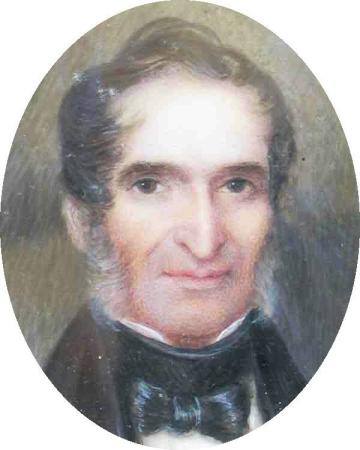Chief Engraver of the U.S. Mint: Christian Gobrecht
Third Chief Engraver of the United States Mint
Continuing in our Chief Engraver series, we’re now on the third man appointed to the position, following after William Kneass; Christian Gobrecht.
Christian was born on December 23, 1785, to parents Reverend John C. Gobrecht; an immigrant from Germany who arrived in America in 1755, and Elizabeth Sands who descended from the early settlers in the Plymouth Colony.
Born in Hanover, Pennsylvania, Christian grew up apprenticing in the art of engraving ornate clocks, and clockwork. After his apprenticeship ended he ventured to Baltimore, Maryland, where he continued engraving clockwork.
Christian enjoyed dabbling in inventions, in 1810 he created a medal-ruling machine which would reproduce relief onto a plain surface. Used for recreating designs onto dies and such. He later improved upon and finalized his design for this machine in 1817.
Shortly after he had started creating the medal-ruling machine, he made another move, this time back to Pennsylvania. Gobrecht made the move to Philadelphia and a couple years later he joined the Murray, Draper, Fairman, and Company engraving firm in 1816.
Gobrecht Begins Working With The U.S. Mint
Fast forward to 1823, given Gorbecht’s talent for engraving and the work he was creating, he caught the attention of Mint Director Robert Patterson. Patterson reached out and asked Gobrecht to be assistant director, but Christian Gobrecht declined the position.
Later that year in November, first Chief Engraver Robert Scot passed away and Robert Patterson then needed to find someone to replace him. Gobrecht applied for the position, but most likely due to William Kneass simply having better connections, the position was given to Kneass instead.
There is extant documentation showing that Gobrecht did indeed work at the Mint around this time, however it seems it was only a temporary position until a Chief Engraver --Kneass-- had been chosen.
It was at this time that Gobrecht also started engraving letter and numeral punches and selling them to the U.S. Mint. He even provided a pattern die to the Mint in 1826. He continued engraving and selling to the Mint most likely until he was hired in 1835 as a “second” engraver.
1835. William Kneass --the current Chief Engraver-- suffered a debilitating stroke that left him paralyzed on one half of his body. He was unable to do his work on engraving dies, and Christian Gobrecht was hired on to assist.
The Gobrecht Dollars
In reality, Gobrecht did nearly all the engraving and pattern work for the remainder of Kneass’ time in office. The Gobrecht dollar was created during this time; the first concept was created by Robert M. Patterson (Son of Robert Patterson), and Gobrecht based the coin on sketches by Thomas Sully, and Titian Peale.
The Gobrecht dollars were minted from 1836-1839 and had many different varieties. Director of the Mint Robert M. Patterson wanted to test out the coins to see how the public reacted. He circulated the coins amongst the “elite and educated” to get feedback on the coins. Patterson believed that a nation would be judged on how successful it was by the artistic and design quality of their largest silver coin. He aimed to make the U.S. the highest quality producers and designers of coinage in the world.
A Bit of Bad Press
During this time, when the coins were circulating amongst a small group of the public, it seems a reporter got their hands on one of the coins. They released a highly critical publication on the coin, slandering Gobrecht for brazenly including his name on the front in such a prominent way.
Gobrecht had signed the coin C. Gobrecht. F. --F standing for the latin fecit meaning “make”, as in he made it--right on the obverse of the coin, just above the date and below the base of Liberty.
Most coins only had --and have-- at the maximum, in very small letters, the engraver’s initials. Never so large and bold as the signature on the Gobrecht dollar. The Gobrecht dollar is the only coin to have the engraver's last name featured in its entirety and nearly as large as a motto.
Considering the outrage that came about over the signature, Patterson ordered changes to be made to make the name less noticeable. Initially the entire signature was just moved to the base of Liberty and made smaller, but ended up being completely omitted in 1838.
A Brief Time in Office
In August, 1840 William Kneass passed away in office, and Christian Gobrecht was appointed Chief Engraver of the United States Mint on December 21, 1840. While in office he created the Seated Liberty coins of quite a few different denominations.
An extremely popular coin amongst coin collectors, many of the Seated Liberty coins are highly sought after valuable additions to any coin collection. It was first minted in 1836, and produced all the way up to 1891! Quite the popular design!
On July 23, 1844 Christian Gobrecht died in office at the age of 58, only four years after he was appointed the position of Chief Engraver. He was succeeded in office by James Barton Longacre, fourth Chief Engraver of the U.S. Mint.
Check out some of our other articles in our Chief Engravers of the US Mint Series!
- Robert Scot
- William Kneass
- Christian Gobrecht
- James B. Longacre
- William Barber
- Charles E. Barber
- George T. Morgan
- John R. Sinnock
All Rights Reserved | CoinCollecting.com


